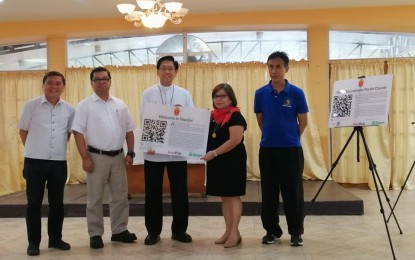
DIGITAL TOURISM. (L-R) Msgr. Julius Heruela, Msgr. Glenn Corsiga, Bishop Julito Cortes, lawyer Ma. Jane Paredes, and Fr. Roman Sagun, lead the launching of Smart Communications' Digital Tourism Program and the turnover of Quick Response Code Markers in Dumaguete City on Monday (July 15, 2019). The project aims to promote awareness on the significance and magnitude of the 500th anniversary of the birth of Christianity in the Philippines. (Photo by Judy Flores Partlow)
DUMAGUETE CITY – In support of the activities leading to the year 2021 celebration of 500 years of Christianity in the Philippines, PLDT wireless unit Smart Communications on Monday launched its Digital Tourism Program in the Diocese of Dumaguete.
Smart Communications officials led by lawyer Maria Jane Paredes, Smart Visayas-Mindanao public affairs head, officially turned over Quick Response (QR) Code markers to key diocese officials headed by Bishop Julito Cortes.
“We decided that we would support efforts of the Catholic celebration via the installation of QR Code markers especially in heritage churches and other places of significance for the celebration,” Paredes told Bishop Cortes and other priests gathered for their regular monthly clergy meeting here.
Initially, seven QR Code Markers were turned over for the island-province of Siquijor, which is part of the diocese’s jurisdiction.
The markers will be installed each in the big parish churches in Siquijor, San Juan, Lazi, Maria, Enrique Villanueva and Larena, plus another “welcome” and “introductory” marker for the island-province.
During the launch and turnover at the Marian Priests’ Center at the Cathedral Compound here, the Smart officials, alongside their partner InnoPub Media, Paredes announced that through its digital tourism program, the company can “promote awareness on the significance and magnitude of this event,” referring to the 2021 celebration spearheaded by the Catholic Bishops’ Conference of the Philippines.
The Digital Tourism Program is not only intended for tourists but for pilgrims coming to visit the different heritage churches or those with historical significance, with the QR Codes providing a fast, convenient, and interactive link to information about a particular site.
This program harnesses technology that provides “timely, relevant, and accurate historical, cultural, religious, and visitor and pilgrim information using mobile apps, QR code markers” as well as mobile guides and other interactive information, she said.
A user needs a mobile device to scan the QR Code to open a web link where all the detailed information of a particular site can be accessed.
The program is also a useful tool for catechism, which, Paredes said, is part of their initiative in supporting the 2021 celebration of the Catholic Church in the Philippines.
Interactive tourism markers have already been installed at the Cebu Metropolitan Cathedral and in heritage churches in Carcar, Argao, Dalaguete, Sibonga, and Boljoon in Cebu province.
In Negros Oriental, the churches in Bacong and Dauin and the Cathedral of St. Catherine of Alexandria in Dumaguete City are up next, although more churches have been identified for inclusion in the Digital Tourism Program.
Bishop Cortes thanked Smart Communications for choosing the Diocese of Dumaguete as its beneficiary and partner for this program.
He said, “our primary audience here are the pilgrims” especially those who visit the churches and this will “lead us to prayers and other spiritual exercises.”
He noted that the content found on the web links even includes specific prayers for the patron saints of particular churches.
“In our diocese, this is a providential initiative that our pilgrims, students, tourists, and even our locals to explore our very own historical and heritage churches,” he said. (PNA)
